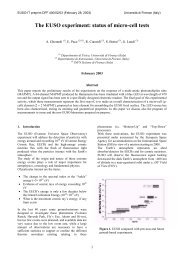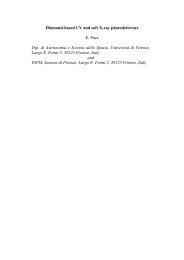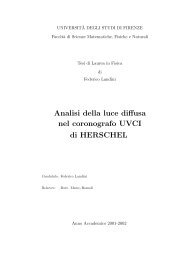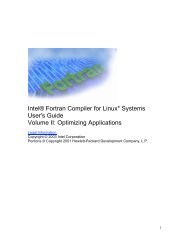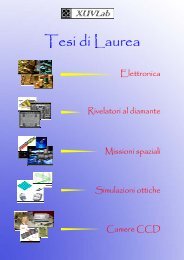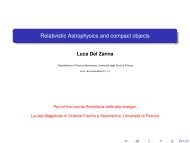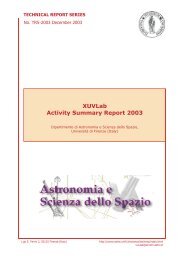Silicon carbide for UV, alpha, beta and X-ray detectors: results and ...
Silicon carbide for UV, alpha, beta and X-ray detectors: results and ...
Silicon carbide for UV, alpha, beta and X-ray detectors: results and ...
You also want an ePaper? Increase the reach of your titles
YUMPU automatically turns print PDFs into web optimized ePapers that Google loves.
RESMDD06, Florence, 10-13 October 2006<br />
<strong>Silicon</strong> <strong>carbide</strong> <strong>for</strong> <strong>UV</strong>, <strong>alpha</strong>,<br />
<strong>beta</strong> <strong>and</strong> X-<strong>ray</strong> <strong>detectors</strong>: <strong>results</strong><br />
<strong>and</strong> perspectives<br />
Francesco Moscatelli 1,2*<br />
1<br />
CNR- IMM di Bologna, via Gobetti 101, 40129 Bologna, Italy<br />
2<br />
INFN Perugia, via Pascoli 1 06123 Perugia, Italy<br />
1
RESMDD06, Florence, 10-13 October 2006<br />
Outline<br />
• Introduction on SiC properties<br />
• α <strong>and</strong> β SiC <strong>detectors</strong><br />
• <strong>UV</strong> SiC <strong>detectors</strong><br />
• X-<strong>ray</strong> SiC <strong>detectors</strong><br />
• Conclusions<br />
2
RESMDD06, Florence, 10-13 October 2006<br />
Wide B<strong>and</strong>gap<br />
E G<br />
=3.2 eV<br />
Low thermally<br />
generated currents<br />
Room temperature<br />
operation<br />
4<br />
3<br />
2<br />
1<br />
0<br />
SiC properties<br />
E g<br />
λ th<br />
Si<br />
GaAs<br />
4H-SiC<br />
(eV)<br />
E c<br />
(MV/cm)<br />
High Critical Field<br />
E C<br />
= 2 MV/cm<br />
(W/cmK)<br />
V s<br />
(10 7 cm/s)<br />
High thermal<br />
conductivity<br />
High saturation<br />
velocity<br />
v S = 200 μm/ns<br />
High<br />
frequency/speed<br />
devices<br />
Short transit time<br />
Low trapping<br />
probability<br />
High Voltage<br />
devices<br />
High Power<br />
devices<br />
3
RESMDD06, Florence, 10-13 October 2006<br />
α <strong>and</strong> β SiC <strong>detectors</strong><br />
4
RESMDD06, Florence, 10-13 October 2006<br />
Schottky junctions<br />
• Two samples<br />
irradiated at<br />
3 × 10 15 n cm -2<br />
• Two samples<br />
irradiated at<br />
circular Schottky contact Ni 2<br />
Si<br />
n - , 4H – SiC, 40 ± 2 μm<br />
epitaxial 4H-SiC<br />
n + , 4H – SiC, 360 μm<br />
substrate<br />
7 × 10 15 n cm -2 Ohmic contact - Ti/Pt/Au<br />
From : S. Sciortino et al. “Effects of heavy<br />
proton <strong>and</strong> neutron irradiations on epitaxial SiC<br />
Schottky diodes”, NIM A 552 (2005) 138-145.<br />
(Technology: Alenia Marconi Systems - Rome)<br />
(SiC wafers: CREE Inc., USA)<br />
(epi:CREE, USA or IKZ, Berlin)<br />
5
RESMDD06, Florence, 10-13 October 2006<br />
Schottky - Charge collection with ΜΙPs<br />
Neutron irradiated sample<br />
Collected charges [e - ]<br />
1600<br />
1200<br />
800<br />
400<br />
Schottky diodes<br />
300 e - at 600 V after<br />
7x10 15 n/cm 2 !<br />
0 2 4 6 8<br />
Fluence [10 15 n/cm 2 ]<br />
6
RESMDD06, Florence, 10-13 October 2006<br />
Schottky - Charge collection with α<br />
particles: neutron irradiated samples<br />
Fluence<br />
S. Sciortino et al. “Effects of heavy proton <strong>and</strong><br />
neutron irradiations on epitaxial SiC Schottky<br />
diodes”, NIM A 552 (2005) 138-145.<br />
7
RESMDD06, Florence, 10-13 October 2006<br />
p + /n junction<br />
terminated<br />
Ti/Al<br />
p +<br />
4 x 10 19 cm -3 p -<br />
0.4 μm<br />
SiC Process: p + /n<br />
(Technology: IMM-CNR – Bologna, Italy)<br />
(SiC wafers: CREE Inc., USA)<br />
(epi: IKZ, Berlin)<br />
5 x 10 17 cm -3 55 μm<br />
n -<br />
2 x 10 14 cm -3<br />
n +<br />
Ion implantation: Al + @ 300°C<br />
~10 18 cm -3<br />
4H-SiC<br />
Post implantation annealing: 1600°C<br />
Ni<br />
<strong>for</strong> 30 min 8° offin Argon<br />
Annealing <strong>for</strong> the contacts: 1000°C <strong>for</strong><br />
2 min in vacuum<br />
Area: 0.0078-0.015 cm 2<br />
0.6 μm<br />
8
RESMDD06, Florence, 10-13 October 2006<br />
p + n: CC measurements on reference<br />
3000 e - @ 200 V <strong>and</strong> 3100 e - @ 600 V <strong>for</strong> diode with D=1 mm*<br />
*F. Moscatelli et al., IEEE Transactions on Nuclear Science<br />
Vol. 53, No. 3 (June, 2006) pp. 1557-1563<br />
9
RESMDD06, Florence, 10-13 October 2006<br />
p + n: I - V after irradiation*<br />
Reverse current<br />
density decreases<br />
after irradiation!<br />
Diameter = 1 mm<br />
*F. Moscatelli et al., IEEE Transactions on Nuclear Science<br />
Vol. 53, No. 3 (June, 2006) pp. 1557-1563<br />
10
RESMDD06, Florence, 10-13 October 2006<br />
p + n: C-V after irradiation<br />
Capacitance is<br />
constant. The<br />
material turns to<br />
intrinsic<br />
Diameter = 0.4 mm<br />
11
RESMDD06, Florence, 10-13 October 2006<br />
Diameter = 1 mm<br />
p + n: CC vs fluence<br />
*F. Moscatelli et al., IEEE Transactions on Nuclear Science<br />
Vol. 53, No. 3 (June, 2006) pp. 1557-1563<br />
• CC is high until<br />
some 10 14 n/cm 2<br />
• CC decreases<br />
sharply after 10 15<br />
n/cm 2 . Only 130<br />
e - after 10 16<br />
n/cm 2* .<br />
12
RESMDD06, Florence, 10-13 October 2006<br />
p + n: Annealing analysis<br />
Concentration of some defects produced by<br />
neutrons decreases as a function of the<br />
annealing temperature*. In particular defects:<br />
-E i at E c -0.5 eV (decreases until 400°C then<br />
vanishes)<br />
-Z 1 /Z 2 at E c -0.62 /0.68 eV (decrease until<br />
900°C then vanish)<br />
- Effects on E c -1.16 <strong>and</strong> E c -1.5 eV?<br />
We want to analyze annealing effects on current<br />
<strong>and</strong> charge collection<br />
* X. D. Chen et al. JAP 94 (5) pp. 3004-3010, Sep 2003.<br />
13
RESMDD06, Florence, 10-13 October 2006<br />
p + n: I-V measurements after 80°C annealing<br />
Average reverse current decreases after annealing at 80°C <strong>for</strong><br />
30 minutes <strong>and</strong> then remains almost constant.<br />
*F. Moscatelli et al, presented at 8 th RD50 Workshop, Prague<br />
June 25-28, 2006.<br />
14
RESMDD06, Florence, 10-13 October 2006<br />
p + n: CC measurements after 80°C annealing<br />
After annealing at 80°C the collected charge slightly<br />
increases, in the range of the experimental error.<br />
No recovery of the damage at 80°C (neither at RT!)<br />
*F. Moscatelli et al, presented at 8 th RD50 Workshop, Prague<br />
June 25-28, 2006.<br />
15
RESMDD06, Florence, 10-13 October 2006<br />
p + n: I-V <strong>and</strong> CC after annealing at 200°C<br />
• CC is 2200±50 e - . (Be<strong>for</strong>e<br />
annealing CC=1800 e -)<br />
increase of 400 e - of CC.<br />
• J (@ 900 V) is 15 nA/cm 2<br />
(be<strong>for</strong>e ann J= 23 nA/cm 2 )<br />
• After an annealing at<br />
200°C <strong>for</strong> 30 minutes we<br />
have a partial recovery of<br />
the damage.<br />
16
RESMDD06, Florence, 10-13 October 2006<br />
p + n: I-V <strong>and</strong> CC after annealing at 400°C<br />
After 30 min at 400°C the current further decreases <strong>and</strong><br />
the CC increases of 40% (from 1400 e - to 1900 e - )<br />
17
RESMDD06, Florence, 10-13 October 2006<br />
Ultra-Violet (<strong>UV</strong>)<br />
<strong>and</strong> Extreme Ultra-Violet (E<strong>UV</strong>)<br />
<strong>detectors</strong><br />
18
RESMDD06, Florence, 10-13 October 2006<br />
QE <strong>and</strong> responsivity<br />
Quantum efficiency is defined as the number<br />
of carriers generated per incident photon<br />
QE<br />
=η =<br />
J ph<br />
q<br />
Φ<br />
i<br />
J ph = photocurrent density<br />
Responsivity (A/W) is the ratio of the photocurrent to the<br />
incident optical power<br />
Φ i<br />
= incident flux<br />
R<br />
=<br />
J<br />
ph<br />
=<br />
J<br />
ph<br />
q<br />
⋅<br />
q<br />
λ ⋅ =η<br />
q<br />
λ<br />
P<br />
i<br />
Φ<br />
i<br />
hc<br />
hc<br />
19
RESMDD06, Florence, 10-13 October 2006<br />
4H-SIC visible blind <strong>UV</strong> avalanche<br />
photodiode (APD)*<br />
V BD = 96 V<br />
positive temperature<br />
coefficient <strong>for</strong><br />
avalanche<br />
breakdown<br />
*F. Yan, Y. Luo, J. H. Zhao <strong>and</strong> G.H. Olsen,<br />
“4H-SiC visible blind <strong>UV</strong> avalanche<br />
photodiode”, Electron. Lett. 35, 929 (1999).<br />
20
RESMDD06, Florence, 10-13 October 2006<br />
Responsivity of APD*<br />
6H-SiC non-avalanche,<br />
R = 170 mA/W<br />
V = −90V<br />
R max =106 A/W at 270nm,<br />
R drops rapidly with<br />
increasing wavelength <strong>and</strong><br />
is comparable to the AC<br />
noise limit at 370nm.<br />
R 270nm /R 370 nm >20<br />
*F. Yan, Y. Luo, J. H. Zhao <strong>and</strong> G.H. Olsen,<br />
“4H-SiC visible blind <strong>UV</strong> avalanche<br />
photodiode”, Electron. Lett. 35, 929 (1999).<br />
21
RESMDD06, Florence, 10-13 October 2006<br />
Ni/4H-SiC Schottky E<strong>UV</strong> photodiodes (1)*<br />
I–V measurement<br />
I = 0.1 pA at −4 V<br />
Ideality factor = 1.06.<br />
*Jun Hu et al., OPTICS LETTERS , Vol. 31, No.<br />
11 June 1, 2006<br />
22
RESMDD06, Florence, 10-13 October 2006<br />
Ni/4H-SiC Schottky E<strong>UV</strong> photodiodes (2)*<br />
• QE (0 V) > 50% from 230 to 295<br />
nm, QE= 65% at 275 nm,<br />
(internal QE ≈100%).<br />
• The rejection ratio of <strong>UV</strong> to<br />
visible light is higher than 1000.<br />
• QE (E<strong>UV</strong>) > 100% <strong>for</strong> λ< 50<br />
nm,<br />
• QE (E<strong>UV</strong>) > 30 e/photon at 3<br />
nm.<br />
*Jun Hu et al., OPTICS LETTERS ,<br />
Vol. 31, No. 11 June 1, 2006<br />
23
RESMDD06, Florence, 10-13 October 2006<br />
4H-SiC single photon counting<br />
avalanche photodiode SPAPD(1)*<br />
V br ≈ 78 V.<br />
The peak QE ≈ 20%<br />
<strong>for</strong> λ= 270 - 280 nm.<br />
The QE ⇓ when λ⇑<strong>for</strong><br />
λ>280 nm because of the<br />
indirect b<strong>and</strong>gap of 4H-<br />
SiC. At 385 nm, the b<strong>and</strong><br />
edge of 4H-SiC, the photo<br />
current is lower than the<br />
system detection limit.<br />
*X. Xin et al., ELECTRONICS LETTERS<br />
17th February 2005 Vol. 41 No. 4<br />
24
RESMDD06, Florence, 10-13 October 2006<br />
4H-SiC SPAPD (2)<br />
At 350 nm QE=1.6%, flux=280<br />
photons/ μs<br />
photon count rate is about 4.5 MHz<br />
(89 signal pulses in 20 μs), n p of<br />
photons absorbed per μsby the SPAD<br />
is 6. The probability <strong>for</strong> n p to be<br />
counted is 75%<br />
The average photon counting<br />
efficiency is there<strong>for</strong>e 1.2%.<br />
At the peak λ = 353 nm, the photon<br />
counting efficiency is estimated to be<br />
2.6% (3.5% QE times 75% counting<br />
probability).<br />
25
RESMDD06, Florence, 10-13 October 2006<br />
X-<strong>ray</strong> <strong>detectors</strong><br />
26
RESMDD06, Florence, 10-13 October 2006<br />
Soft X-<strong>ray</strong> Absorption length<br />
10mm<br />
Absorption Length, λ<br />
1mm<br />
100µm<br />
10µm<br />
1µm<br />
Diamond<br />
SiC≡Si<br />
SiC = Si<br />
0.1 1 10 30<br />
Photon Energy [ keV ]<br />
λ SiC ≤λ Si<br />
Can SiC compete with Si Si ? (!)<br />
27
RESMDD06, Florence, 10-13 October 2006<br />
Electron-hole pairs : Signal !<br />
Semiconductor Semiconductor E GAP GAP<br />
εε<br />
e-h e-h pairs pairs<br />
@ 10 10 keV keV<br />
Ge Ge 0.7 0.7 3.0 3.0 3.3 3.3 k<br />
Si Si 1.1 1.1 3.7 3.7 2.7 2.7 k<br />
GaAs GaAs 1.4 1.4 4.2 4.2 2.4 2.4 k<br />
CdTe CdTe 1.5 1.5 4.5 4.5 2.2 2.2 k<br />
4H-SiC 3.3 3.3 7.8 7.8 1.3 1.3 k<br />
What about the SiC detector noise ?<br />
28
RESMDD06, Florence, 10-13 October 2006<br />
Run of SiC X-Ray Detectors<br />
(Technology: Alenia Marconi Systems - Rome)<br />
(SiC wafers: CREE Inc., USA)<br />
Schottky contact - Au<br />
n - epilayer 5x10 14 - 70 μm<br />
n+ buffer 1 μm<br />
n+ substrate - 320 μm<br />
ohmic contact - Ti/Pt/Au<br />
G. Bertuccio, “Prospect <strong>for</strong> energy resolving X-<strong>ray</strong><br />
imaging with compound semiconductor pixel<br />
<strong>detectors</strong>, NIM A 546 (2005) 232-241<br />
29
RESMDD06, Florence, 10-13 October 2006<br />
Leakage Current Density<br />
State of the art <strong>detectors</strong><br />
Current density [ A / cm 2 ]<br />
10 -8<br />
10 -10<br />
10 -12<br />
10 -6 10 -14<br />
CdTe<br />
Room Temperature<br />
GaAs (SI LEC)<br />
CdZnTe<br />
<strong>Silicon</strong><br />
GaAs (VPE)<br />
200<br />
200<br />
4H-SiC (Epi)<br />
10 -6<br />
Si<br />
1 nA/cm 2<br />
10 -8<br />
SiC<br />
5 pA/cm 2<br />
10 -10<br />
10 -12<br />
10 -14<br />
0,1 1 10 100<br />
Mean electric field [ kV / cm ]<br />
G. Bertuccio et al., IEEE Trans. Nucl. Sci. 50 (2003), pp. 175-185<br />
30
RESMDD06, Florence, 10-13 October 2006<br />
Temperature effect: SiC vs. Si<br />
10 -8<br />
10 -9<br />
10 -10<br />
10 -11<br />
10 -7 1000<br />
67 °C<br />
Current density [ A/cm 2 ]<br />
<strong>Silicon</strong><br />
47 °C<br />
27 °C<br />
200<br />
4H-SiC<br />
67 °C<br />
47 °C<br />
27 °C<br />
10 -12<br />
1 10 100<br />
Mean Electric Field [ kV/cm ]<br />
Higher per<strong>for</strong>mance of SiC with respect to <strong>Silicon</strong> is significant above<br />
room temperature, especially <strong>for</strong> relatively large area <strong>detectors</strong> in which the<br />
leakage current constitutes the main noise source*.<br />
*G. Bertuccio et al.,” A new generation of X-<strong>ray</strong><br />
<strong>detectors</strong> based on silicon <strong>carbide</strong>”, NIM A 518 (2004)<br />
433–435<br />
31
RESMDD06, Florence, 10-13 October 2006<br />
Experimental Results on SiC Detectors*<br />
• 4 x 4 matrix<br />
*G. Bertuccio, “Prospect <strong>for</strong> energy resolving X-<br />
<strong>ray</strong> imaging with compound semiconductor pixel<br />
<strong>detectors</strong>, NIMA 546 (2005) 232-241<br />
• Pixel size: 400 μm x 400 μm<br />
Sub-electron noise at RT!!!<br />
32
RESMDD06, Florence, 10-13 October 2006<br />
SiC pixel detector: from 27 °C to 100°C<br />
T = 100°C<br />
797 eV FWHM<br />
13.9 keV<br />
17.8 keV<br />
241 Am<br />
*G. Bertuccio,<br />
NIMA 546<br />
(2005) 232-241<br />
Counts<br />
T = 27°C<br />
315 eV FWHM<br />
26.3 keV<br />
Np L X-<strong>ray</strong>s<br />
0 5 10 15 20 25 30<br />
Photon Energy [ keV ]<br />
At high T the resolution is limited by the<br />
Front-end, NOT by the detector!!!<br />
33
RESMDD06, Florence, 10-13 October 2006<br />
Front-end noise<br />
Necessity of a new<br />
front-end with noise<br />
of few electrons<br />
New CMOS integrated charge<br />
preamplifier with ENC=3.9 e - + 6.2 e - /pF<br />
<strong>for</strong> <strong>detectors</strong> with 0.5 pF capacitance <strong>and</strong><br />
<strong>for</strong> power consumption of 2.3 mW*.<br />
* courtesy of G. Bertuccio <strong>and</strong> S. Caccia, ”Progress in ultra low<br />
noise ASIC’s <strong>for</strong> radiation <strong>detectors</strong>” to be published on NIM<br />
34
RESMDD06, Florence, 10-13 October 2006<br />
Conclusions α <strong>and</strong> β<br />
• Current<br />
– Currents @ 500 V are very low even after fluences of the order of<br />
10 16 n/cm 2 .<br />
– Currents decrease after annealing at 80°C, 200°C <strong>and</strong> 400°C.<br />
• Capacitance<br />
– Capacitance is constant. The material turns to intrinsic<br />
• CC<br />
– CCE is 100% be<strong>for</strong>e irradation. CC is good until fluences of the<br />
order of some 10 14 n/cm 2 . Be<strong>for</strong>e annealing , <strong>for</strong> fluences of the<br />
order of 10 15 -10 16 n/cm 2 the CC <strong>for</strong> α <strong>and</strong> β is very low.<br />
– After annealing at 80°C a slight increase of the collected charge is<br />
observed, in the range of the experimental error. No recovery of the<br />
damage!<br />
– After annealing at 400°C <strong>for</strong> 30 min an increase of the CC of the<br />
order of 40% is obtained.<br />
35
RESMDD06, Florence, 10-13 October 2006<br />
Conclusion <strong>UV</strong> <strong>detectors</strong><br />
• 4H-SiC visible blind <strong>UV</strong> avalanche <strong>detectors</strong> with V BD =96 V<br />
<strong>and</strong> R max =106 A/W at 270nm. At 370 nm R is equal to noise<br />
limit<br />
• E<strong>UV</strong> <strong>detectors</strong>: QE (0 V) > 50% from 230 to 295 nm, QE=<br />
65% at 275 nm, (internal QE ≈100%). The rejection ratio of <strong>UV</strong><br />
to visible light is higher than 1000. QE (E<strong>UV</strong>) > 100% <strong>for</strong> λ<<br />
50 nm, QE (E<strong>UV</strong>) > 30 e/photon at 3 nm.<br />
• SPAPD <strong>detectors</strong>:V br ≈ 78 V. The peak QE ≈ 20% <strong>for</strong> λ= 270 -<br />
280 nm. At 370 nm QE is equal to noise limit. Photon count rate<br />
is about 4.5 MHz (89 signal pulses in 20 μs), n p of photons<br />
absorbed per μs by the SPAD is 6. The average photon counting<br />
efficiency is there<strong>for</strong>e 1.2%. At the peak λ = 353 nm, the photon<br />
counting efficiency is estimated to be 2.6%.<br />
36
RESMDD06, Florence, 10-13 October 2006<br />
Conclusion X-<strong>ray</strong><br />
• SiC has the same absorption length as Si<br />
• SiC can give superior resolution at certain T <strong>and</strong> Areas<br />
• Pixel <strong>and</strong> pad <strong>detectors</strong> have been fabricated<br />
• SiC pixel detector: 315 eV FWHM @ 27 ° C<br />
797 eV FWHM @ 100 °C<br />
(due to Front-end)<br />
• SiC pixel : sub-electron noise at RT<br />
• New front-end with ENC=3.9 e - + 6.2 e - /pF<br />
37
RESMDD06, Florence, 10-13 October 2006<br />
Acknowledgements<br />
• Prof. A. Scorzoni, University of Perugia, Italy<br />
• Dott. R. Nipoti, IMM-CNR of Bologna , Italy<br />
• Dott. A Poggi, IMM-CNR of Bologna , Italy<br />
• Ing. P. Maccagnani, IMM-CNR of Bologna , Italy<br />
• Dott. S. Sciortino, Dipartimento di Energetica <strong>and</strong> INFN of Florence , Italy.<br />
• Dott. S. Lagomarsino, Dipartimento di Energetica <strong>and</strong> INFN of Florence , Italy.<br />
• Prof. Mara Bruzzi, Dipartimento di Energetica <strong>and</strong> INFN of Florence , Italy.<br />
• Prof. G. Bertuccio, Politecnico of Milano , Italy<br />
• IKZ institute of Berlin (Germany) <strong>for</strong> the epilayer growth,<br />
• The clean room staff of “CNR-IMM Sezione di Bologna , Italy” <strong>for</strong> the device<br />
realization<br />
• The Jozef Stefan Institute (Ljubljana, Slovenia) <strong>for</strong> the neutron irradiation.<br />
38
RESMDD06, Florence, 10-13 October 2006<br />
Appendix<br />
AX<strong>UV</strong><br />
Photodiodes ,<br />
International<br />
Radiation<br />
Detectors Inc.<br />
39


